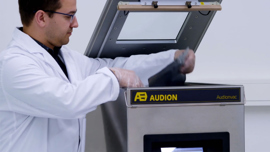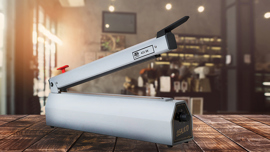How do you choose the right sealer?
How do you choose the right sealer? The choice of sealer consists of 4 elements: the packaging material, the capacity, the packaging format and the desired mobility. The packaging and the requirements of the packaging process determine which sealers are suitable. In this article, we outline these 4 factors in the decision-making process and explain step by step how to choose the right sealer.
Packaging material for hand sealers
The choice of a sealing device always begins by answering the same two questions: which product is the packaging machine being used for and how is the product being packaged? The answers to these questions determine the packaging material.
Requirements of packaging materials can vary significantly and are influenced by the product, the function of the packaging and other conditions. For instance, the requirements for packaging coffee beans vary substantially from packaging requirements in the medical world. The requirements of the product are key, for example storage life or protection of the product. The choice of packaging material is also dependent on the weight – logically, a heavier product requires a stronger packaging.
In addition to the product requirements, the function of the packaging also plays a role in the requirements placed on the packaging material. The material of a packaging that merely needs to contain the product differs significantly from presentation packagings. As such, this also influences the choice of sealing device.
Finally, there are external conditions that can contribute to the packaging requirements – for instance, requirements for transporting the product or sustainability goals. Choices such as reuse, recycling or a reduced environmental impact play a part in the choice of packaging material.
Packing coffee at Fascino roastery
Capacity of hand sealers
Besides the packaging material, the number of packagings to be handled plays a major role in the choice of sealer. How many packagings will you be sealing per minute, per hour or per day? Hand sealers are ideal for handling relatively small numbers, up to approximately 200 packagings per day. However, there are 2 different types of sealing devices available, impulse and heat sealers. The expected number of packagings determines which of these two technologies is best suited for the packaging process.
The difference between impulse and heat sealers is actually fairly simple. An impulse sealer is not continually hot but has a resistance wire which is momentarily heated up each time it is used. A heat sealer, when it is switched on, is always hot.
In a process in which a maximum of 6 packagings per minute are handled, an impulse sealer is a good solution. This type of sealer is not continuously heated, which makes it more suitable for processes which are interrupted. A heat sealer is a better fit for a continuous process in which more packagings are handled and speed plays a role, because it is constantly hot.
Packaging width and seal length
Based on the packaging material and the number of packagings to be handled, we can choose the sealing method: heat or impulse. After that, the width of the packaging determines the sealing length. The sealing length is the length of the sealing bar on the sealer. This must always be slightly greater than the packaging width, but not too long in order to prevent wear and tear to the sealer.
If you are going to be sealing packagings of different widths, you should base the sealing length on the widest packaging. Consider the usage frequency of the different packagings. The sealer wears quickly if the same part of the sealing bar regularly remains unused. In that case, it may make sense to add a second sealer to the packaging process for narrower packagings.
Audion hand sealers are available in various sealing lengths, from 150 mm to 2500 mm. The width of the seal ranges from 1 to 15 mm.
Mobility
Is the packaging process static or mobile? A static packaging process always takes place at the same location. This process is suitable for a table sealer which is placed on a workbench. This facilitates comfortable and accurate working for the person who seals the packages. Audion sealers can be supplied with various accessories, such as wheeled supports which allow our sealers to be deployed at virtually any location.
In processes in which the packaging of products takes place at multiple locations, sealing tongs offer mobility benefits. Compared to a table sealer, this type of sealer is easy to carry to the product, where it can be sealed in situ. This is a great benefit if the product cannot easily be moved, for instance. The tongs are available as both impulse and heat sealers and in different dimensions for a flexible approach to the product. A wall-mounted stand is available for the sealing tongs, which can be used to safely store the device when it is not in use.




![VAL PSR 520 [1]](/media/yf5kc4wo/val-psr-520-1.jpg?width=528&height=396&v=1d8486bdbf50c80)






